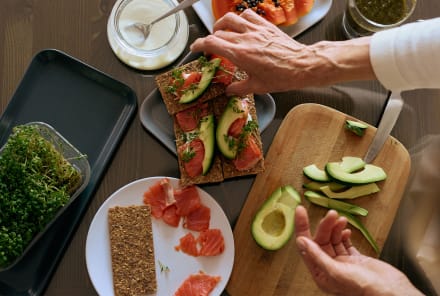Advertisement
These Lifestyle Tips Can Change The Way Your Body Holds On To Fat


A recent study taught us something interesting about body fat and heart disease. Essentially, the research—published in the European Heart Journal—showed that the way a person holds on to fat is more important than how much fat they actually have. More specifically, it suggested that holding weight in your legs (aka, being "pear-shaped") is associated with a much lower risk for cardiovascular disease than being apple-shaped, which is when you tend to accumulate fat around your midsection.
This got many of us thinking: How do we encourage healthier body fat distribution? Is that even possible? We asked Nour Zibdeh, M.S., RDN, a functional and integrative dietitian and nutritionist, and Robert Graham, M.D., MPH—a Harvard-trained physician and integrative medicine specialist—to weigh in. Here's what they had to say about fat distribution and what we can do to promote the healthy kind.
Leg fat versus belly fat.
According to Graham, "This study does add to the literature on the role visceral fat [another word for the fat that accumulates around the midsection] distribution in obesity is closely linked with metabolic complications." That's good to know—but is there anything we can do about it? According to Graham, there are things we can do to encourage healthier fat distribution in the body. That said, he also explained that "We must be mindful of the effect due to ethnic differences in fat distribution, nearly 50% of fat distribution may be determined by genetics."
OK, so some of it is up to fate. But we also have some control over how our body holds on to fat! Graham suggests these six lifestyle changes:
1. Choose complex carbs.
Complex carbs like sweet potatoes, oats, and beans digest at a slower rate, so insulin doesn't spike in an unhealthy way. Your insulin levels stay steady, thus decreasing fat storage around the middle.
2. Avoid unhealthy fats—but eat the healthy ones.
Eat healthy fats; focus on monounsaturated fatty acids (like those in olive oil, nuts, and avocado) and polyunsaturated fatty acids (like the omega-3s fats found in fish). Try to reduce your intake of saturated fats and especially avoid trans fats, which tell our bodies to store fat in very damaging ways.
3. Manage your stress.
Cortisol spikes have been shown to add fat to your belly. In fact, some functional medicine experts think belly fat is more about hormones than what you eat.
4. Sweat every day.
Get at least 30 minutes of exercise a day, increasing the intensity to the point where you're really sweating but not so much that it triggers your stress response, which can be counterproductive.
5. Catch plenty of zzz's.
Make sure you're getting at least six to eight hours of sleep every night. According to Graham, "Less than six hours has been correlated with fat gain and other cardio-metabolic complications."
6. Connect with the people around you.
As Graham puts it, "Other people matter" are the three most important words in the emerging field of positive psychology. The point he's trying to make is that our health is influenced greatly by the people around us. In a landmark 2007 study, researchers found that a person's chance of becoming obese increased by 57% if he or she had a friend who became obese in the same time period.
If you tend to hold on to weight in your midsection, try making one (or a few!) of these lifestyle changes and see if it helps target that area, specifically.
Hormones and the "pear shape."
If you consider yourself more pear-shaped, you likely have a lower risk of developing cardiovascular disease and other related illnesses. That said, according to Zibdeh, it's not as simple as villainizing belly fat and asking no further questions. "Accumulating fat in the legs, thighs, and hips is often related to having too much estrogen floating in the body, or estrogen dominance." This can come with its own set of health challenges. "Estrogen dominance results when we hold on to too much estrogen because the liver and the gut can't get rid of the excess, or when we get exposed to too much estrogen from our environments (like plastics) or foods supply.”
If you accumulate weight around your thighs, butt, and hips, Zibdeh suggests incorporating more cruciferous vegetables like broccoli, cabbage, cauliflower, and Brussels sprouts. "They have compounds that help detox and process estrogen. Plus, their high-fiber and low-carb content makes them appealing on any weight loss plan," she explained.
Speaking of fiber, she also suggests supercharging your fiber intake by way of fiber-rich foods like oat bran, psyllium husk, chia seeds, beans, and the skins of vegetables and fruits. According to Zibdeh, "Fiber helps absorb free-floating estrogen to get rid of it. It also helps nourish gut bacteria, which can impact hormones as well."
The take-home? While belly fat is associated with a higher risk of developing cardiovascular disease and having metabolic issues, we still have to look at the full picture. Accumulating weight in any one place can be a sign that something is out of balance with our overall health.
Watch Next
Enjoy some of our favorite clips from classes
Enjoy some of our favorite clips from classes
What Is Meditation?
Mindfulness/Spirituality | Light Watkins
Box Breathing
Mindfulness/Spirituality | Gwen Dittmar
What Breathwork Can Address
Mindfulness/Spirituality | Gwen Dittmar
The 8 Limbs of Yoga - What is Asana?
Yoga | Caley Alyssa
Two Standing Postures to Open Up Tight Hips
Yoga | Caley Alyssa
How Plants Can Optimize Athletic Performance
Nutrition | Rich Roll
What to Eat Before a Workout
Nutrition | Rich Roll
How Ayurveda Helps Us Navigate Modern Life
Nutrition | Sahara Rose
Messages About Love & Relationships
Love & Relationships | Esther Perel
Love Languages
Love & Relationships | Esther Perel

















